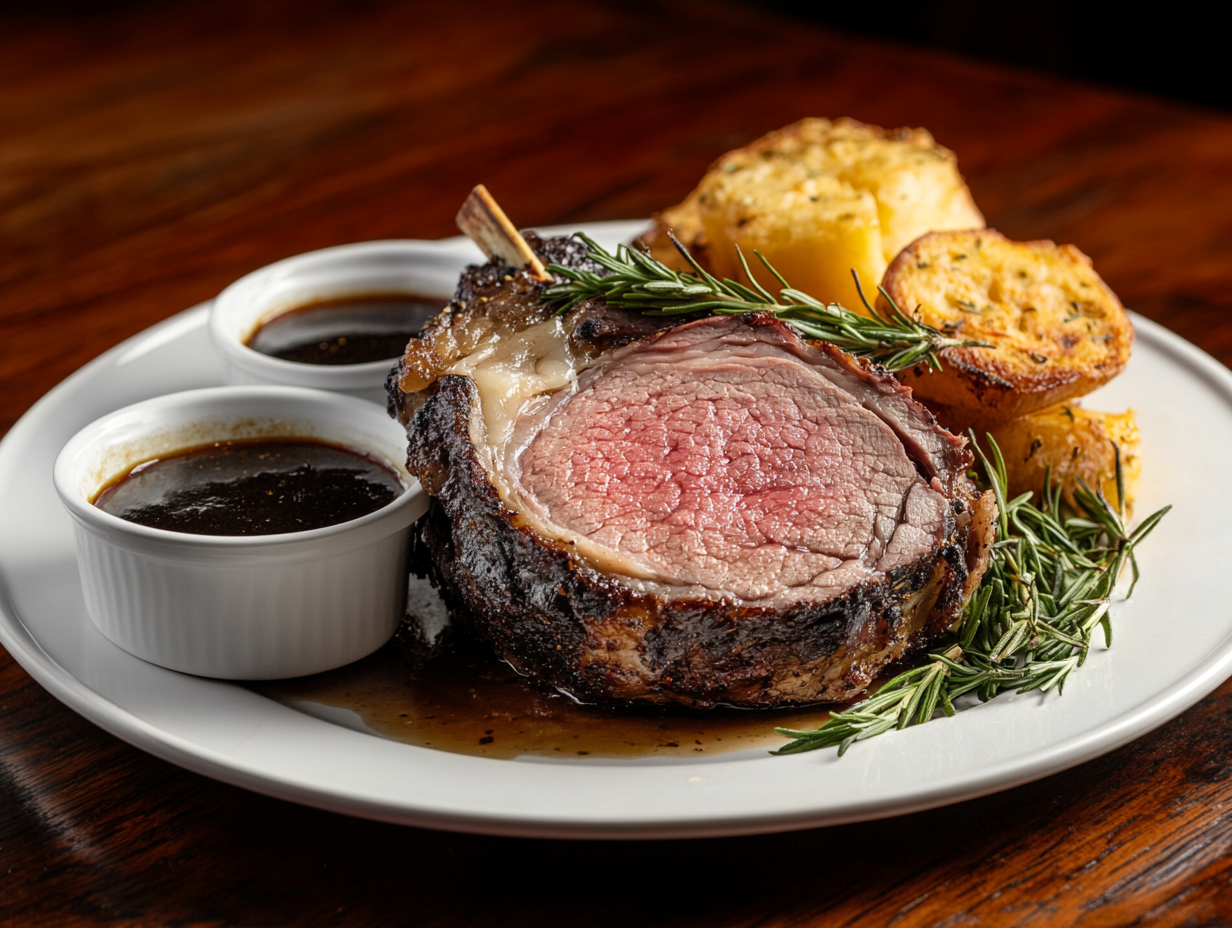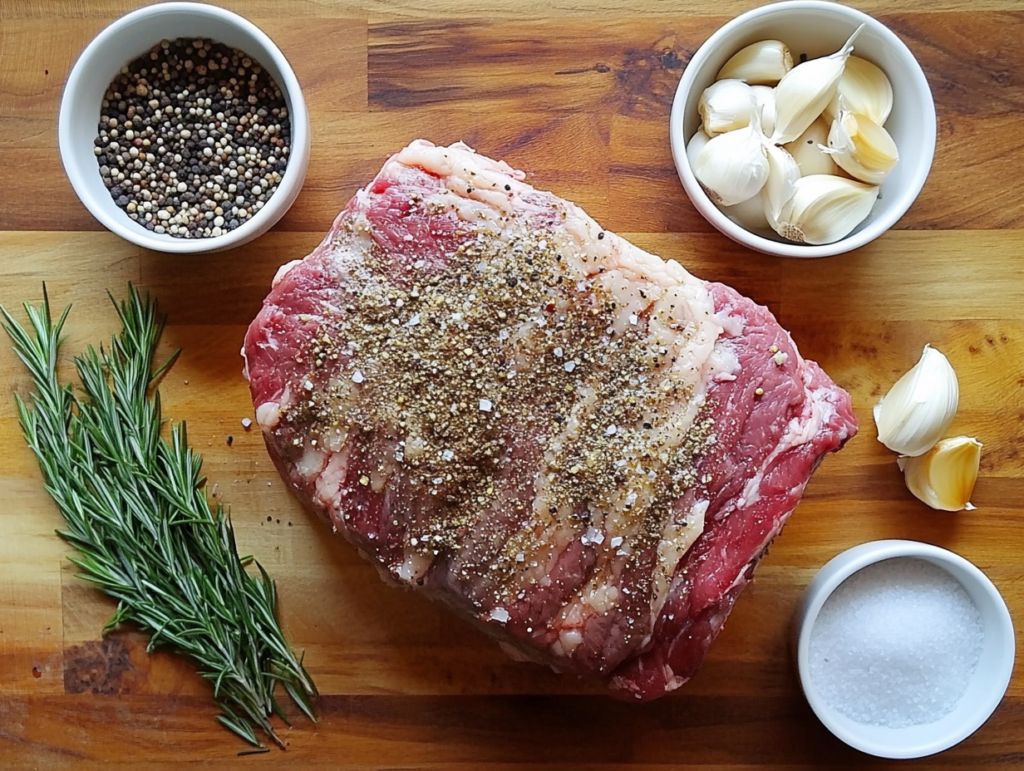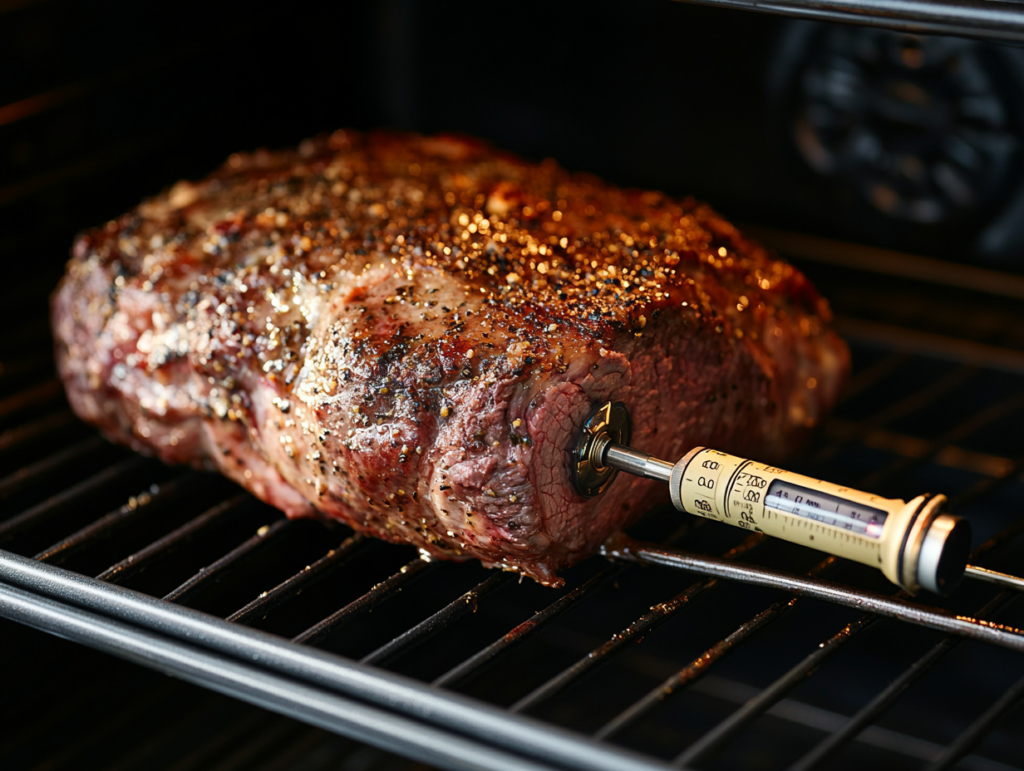Introduction
Cooking the perfect Prime Rib Roast is a culinary milestone. Known for its rich flavor and tender texture, this dish is a centerpiece for holiday meals, celebrations, and special gatherings. From understanding the cut to mastering cooking techniques, this guide will help you achieve flawless results. Whether you’re new to roasting or a seasoned cook, you’ll find all the steps and tips needed to prepare, roast, carve, and serve a delectable Prime Rib Roast. Let’s start by understanding what makes this dish so iconic.
For another impressive main course option, try our Honey Pineapple Baked Chicken Recipe for a sweet and savory twist.
What Is Prime Rib Roast?
Understanding Prime Rib Roast
Prime Rib Roast comes from the rib primal section of the cow, known for its marbling and tenderness. It’s also called a standing rib roast because the bones can help the meat stand upright during cooking. This luxurious cut delivers exceptional flavor and a melt-in-your-mouth texture when cooked properly.
Why Is It a Holiday Favorite?
- Flavorful and Juicy: The marbled fat enhances both the flavor and moisture of the roast.
- Impressive Presentation: Its size and rich color make it a striking centerpiece on any table.
- Versatility: Can be seasoned to suit various tastes and prepared using different cooking techniques, making it adaptable for any occasion.
If you’re a fan of flavorful roasted dishes, our Roast Chicken with Vegetables offers a simpler but equally delicious option.
Understanding the Cut
To cook the perfect Prime Rib Roast, you need to start with the right cut. Knowing what to look for when purchasing your roast can make all the difference in flavor, texture, and presentation.
Anatomy of Prime Rib Roast
- Where It Comes From:
Prime Rib Roast is cut from the rib primal section of the cow, located between the chuck and the short loin. This section is prized for its tenderness and marbling. - Bone-In vs. Boneless:
- Bone-In: The bones provide extra flavor and can act as a natural roasting rack.
- Boneless: Easier to carve and serve, but slightly less flavorful than the bone-in version.
Grades of Beef
- USDA Prime: The highest grade, featuring abundant marbling and the richest flavor.
- USDA Choice: More affordable than Prime, with good marbling and tenderness.
- USDA Select: Less marbled and leaner, often less tender and flavorful.
When choosing your Prime Rib Roast, always opt for the highest grade your budget allows.
Selecting the Right Size
- How Much to Buy: Plan for approximately 1 pound per person for a bone-in roast or ¾ pound per person for boneless. This ensures generous servings while accounting for shrinkage during cooking.
- Servings Guide by Weight:
- A 4-bone roast (~8 pounds) serves 8–10 people.
- A 2-bone roast (~4 pounds) serves 4–5 people.
Preparing the Prime Rib Roast
Proper preparation is key to achieving a tender, flavorful Prime Rib Roast. From seasoning techniques to handling the meat, these steps will ensure your roast is ready for the oven.
Seasoning Techniques
1. Dry Rubs
- A dry rub enhances the crust and infuses the roast with bold flavors.
- Basic Dry Rub Recipe: Combine kosher salt, freshly cracked black pepper, garlic powder, smoked paprika, and dried rosemary.
- Generously coat the entire roast with the rub, pressing it into the meat for maximum flavor.
2. Wet Marinades
- Wet marinades can add extra moisture and flavor to your roast.
- Marinade Recipe: Mix olive oil, soy sauce, minced garlic, fresh thyme, and lemon juice. Place the roast in a large zip-top bag or container and marinate for 4–6 hours in the refrigerator.
For holiday meal planning, check out our guide on How to Cook Turkey in an Electric Roaster for another crowd-pleasing centerpiece.
Bringing the Roast to Room Temperature
Allowing your Prime Rib Roast to come to room temperature before cooking ensures even roasting. Remove the roast from the refrigerator and let it rest for 1–2 hours on the counter. This step prevents cold spots that can result in uneven cooking.
Tying the Roast
Why Trussing Is Important
- Tying the roast helps it maintain its shape during cooking, promoting even heat distribution. It also ensures that the meat cooks uniformly and looks impressive when served.
How to Truss the Roast
- Use butcher’s twine to wrap the roast tightly in 2-inch intervals.
- Secure the ends by tying the twine in a knot.
Cooking Methods
Cooking a Prime Rib Roast to perfection requires the right method. Whether you prefer a classic roast, reverse sear, or sous vide approach, each technique has its unique advantages. Let’s explore these options step by step.
Traditional Oven Roasting
Step-by-Step Instructions
- Preheat the Oven: Set your oven to 450°F (232°C).
- Prepare the Roast: Place the seasoned and tied roast on a roasting rack inside a roasting pan, fat side up.
- Initial Sear: Roast for 20 minutes at 450°F to create a flavorful crust.
- Lower the Temperature: Reduce the oven temperature to 325°F (163°C) and continue cooking until the internal temperature reaches your desired doneness (see the guide below).
Cooking Times (Approximate):
- Rare (120–125°F): 11–12 minutes per pound.
- Medium-Rare (130–135°F): 13–14 minutes per pound.
- Medium (135–140°F): 14–15 minutes per pound.
Reverse Searing Technique
Why Choose Reverse Searing?
Reverse searing involves slow-cooking the roast first and finishing with a high-temperature sear, resulting in even doneness and a crisp crust.
How to Reverse Sear a Prime Rib Roast:
- Preheat your oven to 250°F (121°C).
- Place the roast on a rack in a roasting pan and cook slowly until it reaches 10°F below your desired doneness.
- Remove the roast from the oven and let it rest for 20 minutes.
- Increase the oven temperature to 500°F (260°C) and sear the roast for 5–10 minutes to form a golden crust.
Sous Vide Cooking
Why Use Sous Vide?
Sous vide cooking offers precise temperature control, ensuring perfect doneness throughout the roast. It’s ideal for achieving a tender and evenly cooked roast.
How to Sous Vide a Prime Rib Roast:
- Season the Roast: Coat with a dry rub or marinade and vacuum seal it in a sous vide bag.
- Set the Temperature: For medium-rare, set your sous vide machine to 132°F (56°C).
- Cook Time: Sous vide the roast for 6–8 hours.
- Finish in the Oven: Remove from the bag, pat dry, and sear in a 500°F oven or hot skillet to develop a crust.
Grilling the Prime Rib
Perfecting the Grill Method:
- Preheat your grill to medium-high heat, creating a two-zone setup (direct and indirect heat).
- Sear the roast over direct heat for 4–5 minutes per side to develop a crust.
- Move the roast to indirect heat and cook until it reaches your desired internal temperature. Use a meat thermometer to monitor progress.
Determining Doneness
Knowing when your Prime Rib Roast is perfectly cooked is essential for achieving the ideal level of doneness. Using a meat thermometer is the most accurate way to monitor the internal temperature.
Using a Meat Thermometer
- Why It’s Important: A thermometer ensures precise cooking, preventing undercooked or overcooked meat.
- How to Use It:
- Insert the thermometer into the thickest part of the roast, avoiding bone or fat, which can give false readings.
- Check the temperature periodically, especially as it nears completion.
Temperature Guide for Doneness
- Rare: 120–125°F (49–52°C)
- Medium-Rare: 130–135°F (54–57°C) (Most recommended for Prime Rib Roast)
- Medium: 135–140°F (57–60°C)
- Well-Done: 145°F+ (63°C+)
Carryover Cooking:
- Remove the roast from the heat when it’s 5–10°F below your target doneness. The internal temperature will rise as it rests.
Checking the Crust and Color
In addition to the internal temperature, a good crust and rich golden-brown exterior are signs of a well-roasted prime rib. Ensure the roast has a deep caramelized crust for maximum flavor.
Resting and Carving the Prime Rib Roast
After cooking your Prime Rib Roast to perfection, the final steps of resting and carving are essential to ensure a juicy and tender result.
Why Resting Is Crucial
- Juice Redistribution: Resting allows the juices to settle and redistribute throughout the meat, preventing them from spilling out during carving.
- Resting Time:
- Let the roast rest for at least 20–30 minutes after removing it from the heat.
- Tent the roast loosely with aluminum foil to keep it warm without trapping steam, which can soften the crust.
Carving the Prime Rib Roast
Tools You’ll Need:
- A sharp carving knife or electric knife.
- A sturdy carving fork for stability.
- A cutting board with a groove to catch juices.
Step-by-Step Carving Instructions:
- Remove the Bones (if applicable):
- For a bone-in roast, slice along the curve of the bones to separate them from the meat. Set them aside for serving or discard if preferred.
- Carve the Roast:
- Slice the roast against the grain into thick, even slices (about ½ to 1 inch thick). Cutting against the grain ensures tender pieces.
- Arrange the Slices:
- Lay the slices on a serving platter for easy access and presentation. Garnish with fresh herbs like rosemary or thyme for added flair.
Serving Suggestions
Now that your Prime Rib Roast is perfectly cooked and carved, it’s time to create a stunning presentation and pair it with the right sides and sauces to make your meal unforgettable.
Accompaniments and Side Dishes
- Classic Side Dishes:
- Yorkshire Pudding: A traditional pairing, perfect for soaking up the juices from the roast.
- Mashed Potatoes: Creamy and buttery, an excellent complement to the roast’s richness.
- Roasted Vegetables: Carrots, Brussels sprouts, and parsnips add color and texture.
- Greens and Salads:
- A fresh Caesar salad or mixed greens with vinaigrette can balance the heaviness of the meat.
- Sauces:
- Au Jus: Made from the roast’s drippings for a rich, savory flavor.
- Horseradish Sauce: Adds a tangy, spicy kick to each bite.
- Garlic Herb Butter: Melts over the warm slices, enhancing the flavor.
Presentation Tips
- Plating the Roast:
- Arrange the slices on a large serving platter. Place the largest slices in the center, flanked by smaller cuts for visual balance.
- Garnishing:
- Add sprigs of fresh rosemary, thyme, or parsley around the roast.
- Place lemon wedges or roasted garlic cloves for added aroma and color.
Pairing Suggestions
- Beverages:
- Serve with sparkling water infused with citrus or a non-alcoholic apple cider to enhance the flavors.
- Bread:
- Offer crusty rolls or sourdough bread for guests to enjoy with the roast and sauces.
Storing and Reheating Leftovers
After enjoying your delicious Prime Rib Roast, you might have leftovers. Properly storing and reheating them will help maintain their flavor and texture for future meals.
Proper Storage Methods
- Cool the Roast Safely:
- Allow the meat to cool to room temperature (no longer than 2 hours).
- Avoid leaving it out too long, as this can compromise food safety.
- Refrigeration:
- Wrap the leftover slices tightly in plastic wrap or aluminum foil. Alternatively, store them in airtight containers.
- Refrigerate for up to 3–4 days.
- Freezing:
- If you won’t eat the leftovers soon, freeze them.
- Wrap individual slices in plastic wrap, then place them in a freezer-safe bag or container to avoid freezer burn.
- Label with the date and use within 2–3 months for the best quality.
Reheating Techniques
- Oven Method (Best for Retaining Juiciness):
- Preheat the oven to 300°F (150°C).
- Place the slices in a baking dish, adding a splash of broth or pan drippings to keep them moist.
- Cover with aluminum foil and heat for 10–15 minutes or until warm.
- Stovetop Method:
- Heat a non-stick skillet over medium heat.
- Add a small amount of broth and warm the slices for 1–2 minutes per side, ensuring they don’t dry out.
- Microwave Method (Quickest Option):
- Place slices on a microwave-safe plate.
- Cover with a damp paper towel to retain moisture and heat in short bursts (30 seconds at a time) until warm.
Creative Ways to Use Leftovers
- Prime Rib Sandwiches:
- Layer slices on crusty bread with horseradish sauce, lettuce, and caramelized onions.
- Stir-Fry:
- Dice the meat and toss it into a vegetable stir-fry for a quick meal.
- Tacos or Wraps:
- Shred the meat and use it as a filling for tacos or wraps, topped with fresh salsa and guacamole.
Frequently Asked Questions (FAQs)
Cooking a Prime Rib Roast can come with plenty of questions. Here are answers to some of the most common queries to help you achieve perfect results.
1. How long should I cook a prime rib per pound?
- For a traditional oven roast at 325°F (163°C):
- Rare: 11–12 minutes per pound.
- Medium-Rare: 13–14 minutes per pound.
- Medium: 14–15 minutes per pound.
Always use a meat thermometer to confirm doneness, as oven temperatures and roast sizes can vary.
2. Should I sear the prime rib before or after roasting?
- Both options work, but they produce slightly different results:
- Before roasting: Searing locks in flavor and creates a crust early.
- After roasting (reverse sear): Slow cooking first ensures even doneness, while the final high-temperature sear creates a crispy crust.The reverse sear is particularly effective for large cuts.
The reverse sear is particularly effective for large cuts.
3. Can I cook a frozen prime rib roast?
- It’s not recommended to cook a frozen roast directly, as it will cook unevenly. Instead:
- Thaw the roast in the refrigerator for 3–4 days. For quicker thawing, use the cold-water method: submerge the roast (wrapped in plastic) in cold water, changing the water every 30 minutes.
4. What is the difference between prime rib and ribeye?
- Prime Rib: A larger cut that includes the bone and is typically slow-roasted.
- Ribeye: A smaller, boneless portion of the rib primal, usually cut into steaks and cooked quickly using high heat.
5. How do I make au jus for prime rib?
- Simple Au Jus Recipe:
- Collect drippings from the roasting pan, skim off excess fat, and pour them into a saucepan.
- Add 1 cup of beef broth and simmer for 5–10 minutes. Adjust seasoning with salt and pepper, and serve warm alongside the roast.
Conclusion
A perfectly cooked Prime Rib Roast is the ultimate showstopper for any holiday meal or special occasion. From selecting the right cut and seasoning it to cooking and carving, every step in this guide has been designed to help you achieve juicy, flavorful results that will wow your guests.
Remember, the keys to success are:
- Choosing a high-quality cut with excellent marbling.
- Using precise cooking techniques and a meat thermometer to ensure your desired doneness.
- Resting the roast to lock in the juices and carving it carefully for an elegant presentation.
With this step-by-step guide, you’re now equipped to confidently prepare and serve a Prime Rib Roast that will become a centerpiece tradition. Whether it’s for family gatherings, celebrations, or even a cozy dinner, this dish is sure to impress every time.
Happy roasting, and enjoy every bite! Let me know if you’d like help creating visuals, printable recipe cards, or additional resources for your article! 😊
For more inspiration, explore our Honey Pineapple Baked Chicken Recipe, and Beef Back Ribs Recipe or learn How to Cook Turkey in an Electric Roaster for additional holiday options. Happy roasting!




3 thoughts on “How to Cook the Perfect Prime Rib Roast: A Step-by-Step Guide”
Comments are closed.